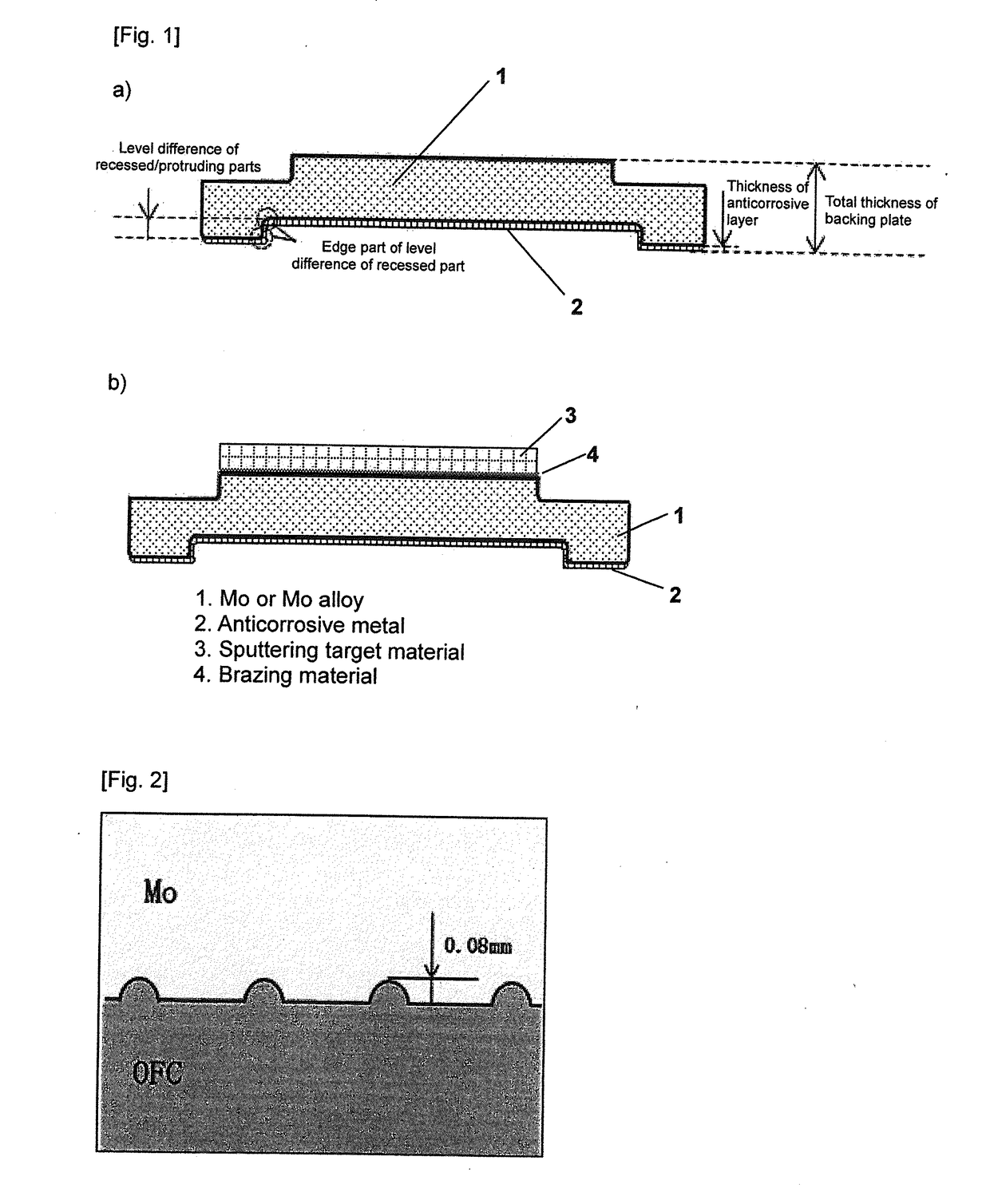Backing Plate Obtained by Diffusion-Bonding Anticorrosive Metal and Mo or Mo Alloy, and Sputtering Target-Backing Plate Assembly Provided with Said Backing Plate
a technology of anticorrosion metal and diffusion bonding, which is applied in the direction of vacuum evaporation coating, coating, electric discharge tubes, etc., can solve the problems of warpage of target material, target material warpage, and deformation of target material, so as to prevent the corrosion of mo, reduce the warpage of sputtering target, and low thermal expansion
- Summary
- Abstract
- Description
- Claims
- Application Information
AI Technical Summary
Benefits of technology
Problems solved by technology
Method used
Image
Examples
example 1
[0052]A specific example of the present invention is now explained with reference to FIG. 1 and FIG. 2. Mo having a purity of 3N was processed into a disk shape having a diameter of 540 mm and a total thickness of 20 mm, and a recess having a diameter of 480 mm and a depth of 4 mm was formed on one surface to prepare a material 1 having a concave side that becomes the base of the backing plate (refer to FIG. 1a), FIG. 1b)). Here, the edge of the level difference part was rounded to R1.5, and grooves having a depth of 0.08 mm were regularly formed on the overall Mo bottom face to yield an anchor effect during bonding (refer to FIG. 2).
[0053]Next, oxygen-free copper (OFC) 2 as the anticorrosive metal was processed such that the edge of the protruding part is R1.5, the diameter is 480 mm, the outer diameter is 540 mm, and the total thickness is 7 mm (refer to FIG. 1a), FIG. 1b)). Furthermore, OFC was processed such that the recessed side is over tolerance and the protruding side is min...
example 2
[0061]A specific example of the present invention is now explained with reference to FIG. 1 and FIG. 3. Mo having a purity of 3N was processed into a disk shape having a diameter of 540 mm and a total thickness of 18 mm, and a recess having a diameter of 480 mm and a depth of 3 mm was formed on one surface to prepare a material having a concave side that becomes the base of the backing plate (refer to FIG. 1). Here, the edge of the level difference part was rounded to R1.5, and grooves having a depth of 0.12 mm were regularly formed on the overall Mo bottom face to yield an anchor effect during bonding.
[0062]Next, aluminum (5052 alloy) as the anticorrosive metal was processed into a bowl shape such that the edge of the protruding part is R1.5, the diameter is 480 mm, the outer diameter is 600 mm, and the total thickness is 21 mm (refer to FIG. 1 and FIG. 3).
[0063]The tolerance of the engaging parts were set to be the same as Example 1. The recess and protrusion of these two material...
PUM
| Property | Measurement | Unit |
|---|---|---|
| diameter | aaaaa | aaaaa |
| depth | aaaaa | aaaaa |
| thickness | aaaaa | aaaaa |
Abstract
Description
Claims
Application Information
 Login to View More
Login to View More - R&D
- Intellectual Property
- Life Sciences
- Materials
- Tech Scout
- Unparalleled Data Quality
- Higher Quality Content
- 60% Fewer Hallucinations
Browse by: Latest US Patents, China's latest patents, Technical Efficacy Thesaurus, Application Domain, Technology Topic, Popular Technical Reports.
© 2025 PatSnap. All rights reserved.Legal|Privacy policy|Modern Slavery Act Transparency Statement|Sitemap|About US| Contact US: help@patsnap.com



